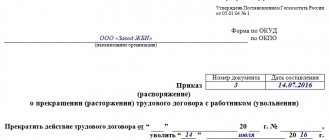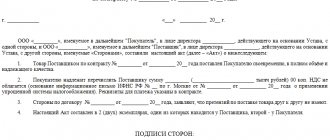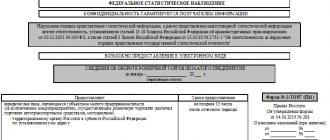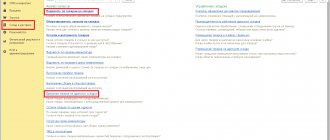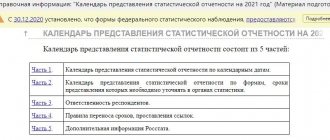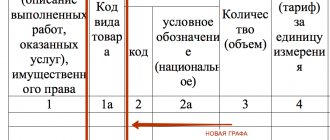TORG-10 is an accounting document related to unified forms. It was approved by the State Statistics Committee of the Russian Federation on December 25, 1998. It is used by trading enterprises when registering transactions for the sale of inventory items.
The form is a list of goods that are ready for sale and packaged in containers, i.e. equipped for transportation.
- 1 Where and in what cases is it used
- 2 Who fills it in
- 3 What documents is it used with?
- 4 How to format correctly 4.1 Filling out algorithm and design recommendations
Who fills out the TORG-10 form
The specification is filled out by organizations that sell goods in closed containers - boxes, barrels - to provide information about the number of places and valuables packed in them. Information about containers and packaged goods is shown separately from each other. The function of filling out the specifications falls on the warehouse employee who packaged the selected goods. The same person certifies the completed document with his signature.
Next, the TORG-10 form in two copies is sent to the person who will deliver the cargo to the recipient, this may be the driver, forwarder or other responsible person. On one copy, the person who accepted the cargo puts his signature confirming receipt of the goods in the container. This copy is returned to the warehouse employee for further storage. There is no need to submit the document to the accounting department; the specification is needed solely for warehouse needs.
The carrier takes the second copy of the specification to the buyer and hands it over with the rest of the shipping documentation. The buyer uses the specification to compare the actual cargo received with documentary data.
Who signs the TORG-10 specification
The completed specification is signed by two people:
- The materially responsible person of the warehouse, performing the function of issuing goods and materials;
- Driver, forwarder, carrier who accepted the goods for transportation.
Together with which documents is the TORG-10 form drawn up?
Along with the specification, a packaging label is issued in the warehouse according to the TORG-9 form; this form is filled out by a warehouse employee who packs the collected goods into closed containers (boxes, barrels, cartons). The label shows information about the product that is contained in each individual location.
The TORG-9 form is filled out in two copies for each place; instead of the third copy for transfer to the buyer, the TORG-10 summary specification is filled out, which collects information for each place. If the specification is not drawn up, then a third copy of the label is additionally prepared for each individual place.
The specification is attached to shipping documents, including:
- Invoice (commodity or goods-transport). Read also the article: → “Consignment note (Bill of Lading). Form and example of filling out form 1-T.”
- Consignment note when delivering cargo by a transport company;
- Invoice if the seller is a payer of added tax (VAT).
About working with the TORG-10 form
This document is issued for an uninvoiced consignment of goods that has been prepared for further transportation. Usually this is a product that is packaged in barrels or boxes. The document contains data on the number of items of goods; the quantity and weight are noted for each item.
The specification in form TORG-10 is a primary accounting document. Filling out the paperwork, as well as packaging the goods, falls on the shoulders of the storekeeper or other financially responsible person. The specification is signed by the storekeeper and the driver (forwarder) upon receipt of the goods. The buyer, using the specification, checks the received cargo with what is listed in it.
For your information! The document must be drawn up in two copies. The first, together with the invoice, is sent to the customer, and the second remains with the financially responsible person.
No amendments are allowed to the specification. If any were accepted, then you need to take a new form to fill out. Data must be indicated in numbers or in words (where necessary). If you do not follow the filling rules, the document will not be considered valid.
Together with the specification, a packaging label is filled out in the TORG-9 form - it contains information about the product of each individual item.
With what documents is TORG-10 transferred to the buyer:
- Waybill.
- Consignment note.
- Account for payment transfer.
- If the seller is a VAT payer, then an invoice.
Details for filling out the specification
To fill out the TORG-10 form, you need the details of the organization and information for each allocated place. This information is taken from the TORG-9 packaging label, which is mandatory for each warehouse facility if goods and materials are packed in closed containers, for example, in boxes, boxes, barrels. The labels are filled out by the packer and then checked by the warehouse release person.
After verification, MOL begins to compile a consolidated specification based on the issued labels.
About the TORG-10 form
This is a unified form. It was approved by the State Statistics Committee by resolution No. 132 of December 25, 1998. Since the beginning of 2013, all forms developed by the state have ceased to be mandatory. That is, companies can now work with those forms that are most convenient for them: developed independently or unified (Clause 4, Article 9 of Federal Law No. 402-FZ “On Accounting”). The main thing is to approve your decision in the company’s accounting policy. This is done by issuing a management order.
The primary accounting document must have certain details. If the company develops the form itself, then this needs to be taken into account. The entire list of details is published in paragraph 2 of Art. 9 Federal Law No. 402-FZ.
Recommendations for the design of the TORG-10 form
The filling procedure is carried out by the financially responsible person who releases the valuables from the warehouse to the carrier. The information to be filled out is taken from the TORG-9 packaging label, which is attached to each packaged item. The specification form was put into effect by the State Statistics Committee in 1998. Resolution No. 132 of December 25, 1998.
The specification must be filled out on both sides:
- The “header” of the document is drawn up on the front side and information is provided for each item released from the warehouse;
- On the reverse side there is a continuation of the table, as well as fields for indicating summary information about the product and container weight; in the lower part there is space for signatures by responsible persons.
In the specification header fill in:
- Information about the organization - name and contact details, OKPO, type of activity according to OKDP;
- Name of the department from which containers with goods are issued;
- Operation type code, if such coding is established in the organization;
- Specification number;
- Compilation date – the day on which the goods are actually released from the warehouse to the carrier’s representative.
The tabular part provides information for each individual place; information on containers in the table is highlighted in a separate column, and is also presented in a summarized form on the reverse side of the TORG-10 form.
The table is filled out as follows:
| Table column number | Information to be filled in |
| 1 | Seat number – information for each place is given on a separate line. The total number of filled lines will be equal to the number of places released. |
| 2 | Generalized name of the goods packed in this place. Additionally, explanatory main characteristics and articles may be indicated. |
| 3 | The number of the packaging label included with this item. The label is drawn up in the TORG-9 form, one copy is placed inside the packaged item. |
| 4 | Type of packaging - box, barrel, box or other name. |
| 5 | Quantitative indicator for each location. |
| 6 | Gross weight, which includes the weight of the product and the container in which it is packaged. |
| 7 | Tare weight – the weight of the container without goods. |
On the reverse side of the TORG-10 form there is a continuation of the table, according to the results of which the total quantity, gross weight and tare weight in digital form are indicated in the “total” line. The same information, but in capital form, is filled in special fields under the table.
The financially responsible person who controls the release of goods and materials, packed in containers, from the warehouse, certifies the completed information with his signature.
Next, two completed copies are handed over to the driver (forwarder) who received the goods for certification. These persons confirm the acceptance of the specified number of places with their signatures, after which one copy is returned to the warehouse representative and filed in a folder for storage. The second copy is pinned to other documents accompanying the goods for transfer to the buyer and use as a basis for acceptance of valuables at the place of delivery.
Design example. The organization Fruit Paradise LLC is engaged in the sale of dried fruits. The next delivery of dried fruits includes:
- 20 cardboard boxes of dried apricots, 10 kg each;
- 30 cardboard boxes of prunes, 10 kg each;
- 30 bags of dried fruit compote mixture, 5 kg each.
The warehouse manager drew up the following specification:
Fill out the TORG-10 form
In the header of the document you must indicate the following information:
- The name of the organization, its address and telephone number.
- OKPO code.
- Name of the structural unit.
- Type of company activity. Specification number and date of its preparation.
The main part follows. It is presented in a table. What needs to be noted in it:
- Product location number. Each individual location is indicated on a separate line.
- Name of the product group, its grade.
- Number of the packaging label (according to the TORG-9 form).
- Type of product packaging. It could be a barrel, a box, a box.
- Number of pieces, places.
- Gross and net weight.
You must remember to summarize the results at the end of the table for the pages and the entire document.
After the table, indicate in words the quantity of goods, gross weight, tare weight. The financially responsible person, the driver and the forwarder sign.
Errors when filling out specifications
Filling out the specification must be carried out taking into account the following rules:
- in the TORG-10 form you need to enter summary information as a whole for the batch being sold;
- each individual location is shown on a separate line;
- at the end, the results are summed up, indicated in words under the table;
- It is mandatory to have certification signatures on both completed copies of the specification.
Failure to comply with these rules will constitute an error in filling out the TORG-10 form. The absence of a signature from the warehouse employee releasing the goods and the driver who accepted the goods will render the document invalid.
What documents is it used with?
Before filling out the specification, the unified TORG-9 form, which is called “Packaging Label,” must be completed. It contains data on valuables packed in a separate place, and is drawn up by an employee of the warehouse department, who is listed as the materially responsible person for storage. It is applied to each packed area. From this primary document, information is transferred to TORG-10.
ATTENTION! If there is no specification, then three copies of TORG-9 are required. When the TORG-10 form is filled out, it is permissible not to draw up a third copy of the document.
The specification accompanies the following accounting documentation:
- waybill and waybill;
- invoice;
- an invoice for payment.
How to register correctly
The specification has two sides: front and back. The first contains:
- address part. It includes all data about the organization: name, address, phone number, OKPO, OKDP codes, division, dispensing products, number and date of compilation. Date – the day on which the goods were actually released from the warehouse to the buyer.
- The table requires filling out data for each place, information about packaging, which should be highlighted in a separate line. The tabular part has the following columns: place number, name of the trade item, package number and quantity, type of packaging, gross weight (weight of goods and containers) and containers (without goods).
The reverse side contains a continuation of the table. Here this information is indicated in general.
Blank lines must be crossed out. In the “Total” line indicate the total amount and quantity, weight of packaging and goods. The lower part of the document has lines where this information must be duplicated in capital form.
IMPORTANT! The document is drawn up in two copies.
Free legal consultation
+7 800 350-51-81
One is needed for accounting. The second is sent to the client along with the invoice. It must have the signature of the employee who accepted the cargo. Usually this is a driver or forwarder who carries out transportation.
The specification is necessary to verify the actual receipt of purchased valuables with the data specified in the accompanying documentation. After signing, an approval stamp is placed - the seal of the enterprise.
Filling algorithm and design recommendations
There should be no corrections in the document. If the completed form contains inaccurate information, it must be rewritten. When TORG-10 is drawn up by hand, black or blue ink is used. All digital information is indicated both in words and in numbers.
All certification signatures must be on the document. If any of the listed requirements are not met, the document drawn up with errors will be considered invalid.
